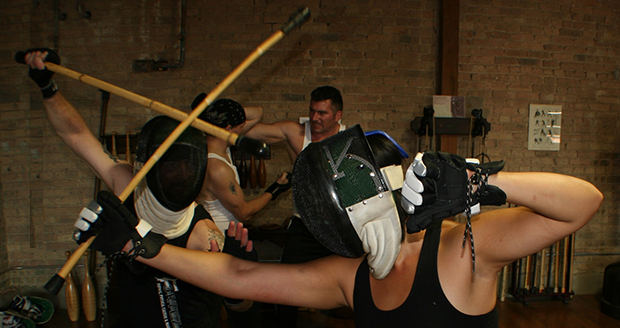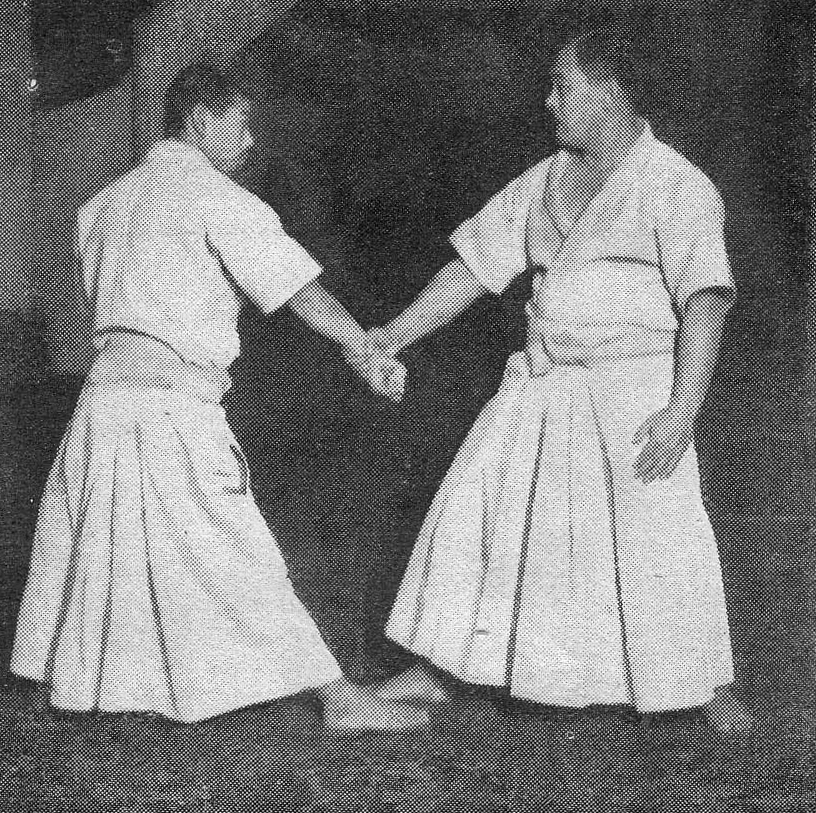- Originally published on the Bartitsu.org site on Monday, 7th May 2018
Bartitsu founder Edward Barton-Wright claimed “the use of the stiletto” among the variety of fighting styles he had studied during his many years as an itinerant mining engineer. Bartitsu itself, however, does not appear to have included any dagger nor knife techniques per se. Indeed, apart from some ambiguous comments by third parties who witnessed Bartitsu demonstrations, the only references to edged weapons in the Bartitsu repertoire were in terms of defending against them, via Barton-Wright’s “coat trick” or the Vigny cane system.
Barton-Wright’s remark that learning his New Art of Self-Defence should relieve students of “the feeling of disgust at having a dagger about (them)” was typical of English sentiment at the turn of the 20th century. Given that cultural bias against bladed weapons, he was careful to frame his discussions of knife attacks as being committed by “foreigners”. That said, knives were, in fact, widely used in Southern European and Mediterranean criminal subcultures.
The following is excerpted from Chapter IV of “The Pillars of Hercules, or, A narrative of travels in Spain and Morocco in 1848”. It offers a unique technical description of Spanish knife fighting/training, written by David Urquhart, an Englishman who learned the art from a Spanish master in Seville.
CHAPTER IV.
PELEA DE NAVAJA. THE OLD SPANISH SWORD.
A Sevillian whom I was questioning about the frequent assassinations, astonished me by denying that there were any. “What you hear of,” said he, “as murders are duels.” I objected the knife;—he said, “Well, the knife, that is our weapon; we fence, we do not stab; the duel has its laws, the weapon its science.” I thought this must be a figurative manner of describing some rude point of honour, and asked him to show me in what consisted the science. “I am not expert,” he said; “but if you are curious I will take you to a friend of mine, whom you can engage, as he is the best player in Seville; and, since the death of Montez, in all Andalusia.”
I begged immediately to be conducted to the yuecador, and was introduced to the inner apartment; which—as he united the calling of contrabandist to that of fencing-master—was filled with bales of tobacco. The subject was broached as a matter of business. He was willing to give me lessons, but would not undertake to teach me. If I had natural dispositions I might learn “to play” in three months, taking Time by the forelock. I proposed commencing at once; and next morning he came to me by day-light, at the inn— for it required a large room.
A wooden dagger is used for a foil: it is about eight inches long, and in form like the old sacrificial knife: it is held by the closed fingers, the thumb stretching along the blade, and the edge turned inward. Round the left arm is wound the jacket as a shield. My teacher, putting himself in attitude, at once reminded me of the fighting Gladiator. He thus commenced: “You must hold your right hand down upon your thigh; you must never raise it till sure of your blow. Your feints must be with the eye—the eye, hand and leg must move together. When you look here, you must strike there, and spring when you have cut, corta y huya. The left arm must be kept high, the right hand low, the knees bent, the legs wide, the toes forward, ready to spring back or forward. There are three cuts and three parries; one point,—the point is low and at the belly—St. George’s au bas venire: the cut must be across the muscle on the shoulder or the breast, or down well into the groin, so as to let out the bowels. Unless you know how to cut, it is of no use knowing how to fence.”
He knew nothing of our fencing, and was much surprised when I made application of it, and attributed the advantages it gave to a natural instinct for the art. The result was, that in a week he had gone through the whole course, and the last day of my stay at Seville, he brought two of the proficients, and we had a regular assault d’armes, the guests at the hotels being spectators. He honoured me at the introduction by saying, that he feared me more than either of his two compeers, because I sprang better than the one, and cut better than the other.
The attitudes are a study for an artist. There are not the stiff figures and sharp angles of our fencing; but the rounded limb, the gathered-up muscle, the balanced body:—instead of the glance of the steel there is that of the eye. The weapon is concealed under the hand, and pointing down, so that not a ray betokens it. There is no boxer’s fist or cestus, no crusader’s helm or hauberk, no Roman’s sword or shield. It seemed as if the hands and the eye of the man were equal to the claw of the tiger, or the tusk of the boar. It was a combat of beasts rather than a contest of men. There was the ambling pace, the slouching gait of the panther or the lion, or, rather, it was a mixture of the snake and the frog; gliding like the one and springing like the other. This is the war of the knife, the Pelea de Navaja, falsely interpreted war to the knife.
After missing a blow with the right hand, the knife, by a dexterous player, may be jerked into the left; but this, if unsuccessful, is inevitable death. To jerk it at your antagonist is not permitted by the rules of the game. By a sudden spring an adversary’s foot may be pinned after he has failed in a blow. The most deadly of these feints is to strike the foot of your adversary sideways and so bring him down. A celebrated Juccador named Montes (not the Torero), killed in this manner eleven men, and was at last so killed himself.
The mantle or jacket round the left arm is used, not for the purpose of catching the blow, but of striking off the adversary’s arm so that he may not reach. The guarding arm is always within reach, but always avoided; for to strike at it would leave your side open, and the safety consists in keeping under your adversary. The arms of the players were all scarred; but that was in ” love fights.” The edge of the knife is then blunted, or a shoulder is put to it, as in the case of the lances which they use with the bulls.
The Sevillian was right. This is not simple assassination: it is not the stab given in the dark, though of course we could only so understand a man being killed by a knife. A popular song at Seville is, the lamentation of a man imprisoned for “stabbing” another :—he exclaims against the wrong ; justifies his legitimate defence of his maja; calls upon the gaoler to testify to his treatment; and, failing to obtain sympathy, rushes to the grates and appeals to the people:—
“Si venga gente pora aca!”
There is no song sung with more fervour by the ladies.
This is the most deadly weapon I know; the dirk, the cama, the dagger, are grasped in the hand, and impelled by the leverage of the arm. The navaja may be so used, or plunged right on end like the Hindoo dagger, and also by the motion of the wrist alone: it more resembles mowing with the scythe than thrusting with a poniard: it is accompanied by the action of the sword, in which, as in fencing, the limbs come into play, and thus serves the purpose of a defensive weapon. It is the origin of our fencing; and against adversaries not acquainted with that art, or not armed for it, it still retains all its ancient superiority:—in all cases it would be a valuable accessory to other weapons, without being an encumbrance, and serving for all the ordinary purposes of a knife.
The navaja (pronounced navakha) is a clasp knife, —those worn by professed players are a foot long when closed. There is a spring to catch it behind, to prevent it closing on the hand. When opened there is the click as in cocking a pistol, and the sound is said to delight Andalusian equally with Irish ears. The art of fencing with it is called pelea de navaja.




























